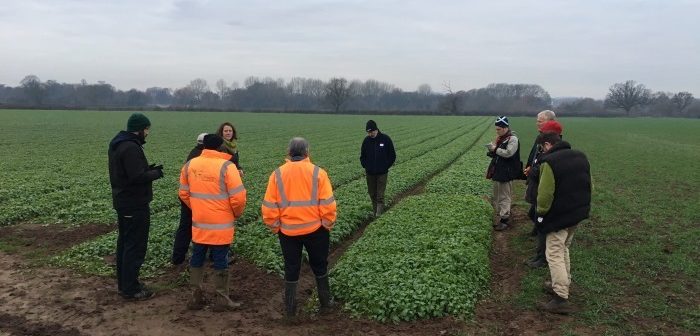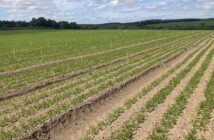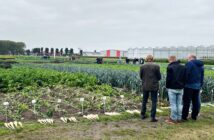AHDB Horticulture-funded knowledge exchange programme ‘GREATsoils’ has seen out a successful 2016, with trial demonstration event held at fresh produce growers, Valefresco.
Valefresco are one of six field trials which aim to compare different soil assessment methods during the 2016 and 2017 growing seasons. The six growers from across the UK range from field vegetables to top fruit orchards, all interested in finding practical methods to assess, monitor and improve soil organic matter in their soils.
The programme has delivered 15 knowledge exchange events ranging from on-farm events to online webinars that have seen 320 attendees made up largely of growers but also agronomists, researchers and consultants.
The GREATsoils programme consists of projects looking at assessing soil health (CP 107b) and another analysing future potential of precision farming to optimise soil and nutrient management (CP 107c).
The Growers Interest
Dr Martin Wood, Earthcare Technical Ltd, said: “I’ve been banging on about the importance of soil for over 30 years but, during the past year, as we’ve delivered talks and workshops as part of the GREATsoils project, I’ve been knocked out by the interest shown by farmers and growers in learning more about how to measure and manage soil health.”
Many growers have recognised the importance in utilising green manures and cover crops – but the cost of growing and fitting them into a tight rotation remains difficult for many.
Anja Vieweger, Senior Researcher, Organic Research Centre, added: “There is a strong focus on soil life and soil organic matter levels. Most growers, across all the different systems, are aware of and concerned about declining SOM levels and see a need for action. They are looking for useful and efficient methods to measure and monitor soil life, but also practical methods for increasing active SOM, ultimately increasing soil fertility and productivity.”
There is an awareness of new technologies from soil scanning to canopy sensing and their potential application in horticulture. However, it is not all about new technologies, as many growers simply want to gain a better understanding of soil and crop variability and how to manage it to improve profitability.
Dr Paul Newell Price, Principal Soil Scientist, RSK ADAS, said: “Growers are interested in how new technologies and approaches can help them do this, whether it is auto steer guidance systems, controlled traffic farming, multispectral cameras on drones or the use of cover crops. Some growers are particularly interested in soil mapping technologies to gather information on newly purchased or rented land. Others are already using imagery to schedule harvesting or variable rate nitrogen applications to even up crop growth.”
What have we learnt?
More growers are trying to increase their use of cover crops and green manures in their sometimes highly intensive rotation. Testing optimal and system-specific approaches for this will be discussed during the second year of the project’s field trials.
“There is a great range in growers’ awareness of soil health and what they are able to influence. There are some examples of the use of green manures and growers wanting to know about the effects on the soil – but these are still in the few,” said Tim Bevan, Farm Business Advisor, Soil Association. “There is a need for more information and predictive tools on how to utilise green manures, and composts can replace chemical inputs meaning a financial benefit for growers.”
Dr Wood echoes: “Some of the best moments happened when we acted simply as catalysts for exchange of knowledge – when growers who had come together for one of our GREATsoils events got out into the field and started to compare experiences of soil management among themselves. It might be about green manures that have worked for them, or about a new soil analysis service that they’ve been trying out.”
From a precision farming adoption approach, many growers are at the enquiry or data gathering stage, trying to understand the variability on their farm. At the other end of the scale, a few growers are working with research institutes and universities to test and validate techniques in the field, including the use of soil scanning, yield potential mapping and crop growth models to variably apply nitrogen.
Dr Lizzie Sagoo, Soil scientist, RSK ADAS said: “We have a much clearer picture of the state of soils under horticultural production, with tillage pans and subsoil compaction widespread issues. This may not be surprising, given the need for planting and late harvesting in poor field conditions, but it highlights the soil management challenges faced by growers. Improving soil structural condition may take many years and can involve significant changes to cultivation and growing systems. However, the benefits in terms of flexibility of operations, evenness of growth, efficiency and profitability could be considerable.”
Bottom line for growers
Growers are increasingly aware of the relationship between soil organic matter, soil structural condition and soil health.
Dr Paul Newell Price, summarises: “The first step is assessment. If we don’t assess it, we can’t manage it. If you’re new to soil structural assessment, use the available tools, such as Visual Soil Assessment (VSA) and Visual Evaluation of Soil Structure (VESS) to help you recognise what good and bad structure looks like. Measuring the depth, degree and thickness of a compacted layer (e.g. a tillage pan) is crucial to selecting the most appropriate cultivation and/or cover cropping method.”
Match your cultivations to the soil structural condition and the need to manage weeds and crop residues, but don’t cultivate any more than you have to. Consider controlled traffic farming; the approach requires total commitment and significant investment, but the benefits can be considerable.
Maintain or enhance soil organic matter levels by applying organic manures
Consider green manures and cover cropping to protect soils (from water and wind erosion)
Capture nutrients, proliferate roots, encourage earthworms and maintain soil structural condition
What’s coming in 2017?
There are some exciting prospects for 2017 as the GREATsoils project releases its first case studies on the use of compost to improve soil health and on a new approach to testing soil for carrot production.
Feedback from our six field trials growers and the results of the different methods for measuring and managing soil health on their own farms, across the country.
Parrish Farms will be hosting a demonstration open day to discuss options for soil mapping in horticulture, looking at costs and benefits associated with different soil mapping techniques.
In June, we’ll be at G’s looking at understanding and managing soil and crop yield variability with a focus on vegetable and salad crops.
Additional demonstration open days are planned on controlled traffic farming (CTF) and variable rate nitrogen




